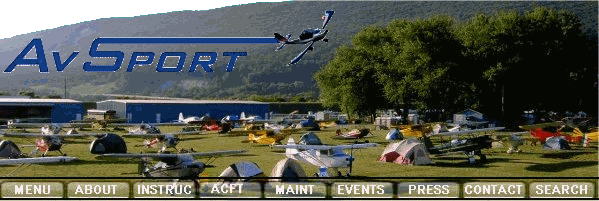
AvSport of Lock Haven -- 353 Proctor Street, Lock Haven PA 17745
Collision Avoidance
Excerpt from Winging It! With Dr. Paul: Forty Tales Your Flight Instructor Never Told You (copyright © 1989 by H. Paul Shuch)

Collision Avoidance
Excerpt from Winging It! With Dr. Paul: Forty Tales Your Flight Instructor Never Told You (copyright © 1989 by H. Paul Shuch)
Anyone crossing the United States by light aircraft is impressed by the immensity of our country and the unbounded sky above it, and by contrast, the relative insignificance of man and his creations. Across vast expanses of this nation, one can fly for hours without sighting a single building, person, or other aircraft. Our sky appears without limit.
In fact, the sky is so vast, and airplanes so minute, that if each of the quarter of a million aircraft in the United States were airborne at the same instant, at the same altitude, over the state of Nevada, each would still have over a square mile of airspace to itself. Further, at any given moment, fewer than two percent of these aircraft are in flight, over all states, at all altitudes. Yet about thirty times a year, two or more aircraft find themselves occupying the same airspace at the same time. Roughly half of the ensuing midair encounters result in fatalities.
In order to reduce the incidence of midair collisions, we need to understand the circumstances under which they are most likely to occur. And although we all tend to keep our heads on a nervous swivel when scud-running (as well we should), the accident figures tell us that the overwhelming majority of midairs occur in daytime, severe-clear conditions. Beautiful weather does two things: it brings out lots of traffic, and it makes us complacent.
One would expect most midairs to occur near airports, and the statistics bear this out. You're most at risk within five miles of a runway, at or below 3000 feet AGL. Weekends are riskier than weekdays. An inordinate number of accidents involve high-time, very experienced pilots. And as mentioned already, the weather is almost always VFR. I guess to be safe, you should only fly with low-time, inexperienced pilots in IMC, at night, during the week, and stay far away from airports!
Uncontrolled fields figure prominently in the accident statistics, as do operations off opposite ends of the same runway. (This makes adherence to "calm wind" runway designations all the more important.) A large number of accidents involve an aircraft making a straight-in approach. Conclusion? Always fly a pattern! And in all too many cases, both aircraft had radios on, on the right frequency, but failed to hear each other on the air. It's not enough to have a radio, you have to use it!
An old fighter pilot's trick (I learned it from an old fighter pilot) is to find your shadow on the ground when you enter the pattern, and keep an eye open for other shadows near it. A hanger mate of mine who flew Night Fighters in WWII tells me this technique never worked for him.
We all have an unreasonable fear of being run over from behind, but a recent Air Safety Foundation study showed that in the majority of midairs, each plane was well within the other pilot's field of view. If you scan well and often from your ten to your two o'clock position, from ten degrees above to ten below your nose, you have a good chance of seeing whoever's out there. That doesn't mean that you shouldn't still check your six, just for good measure, at every opportunity!
The most advanced collision avoidance technology works so well that today most pilots are issued two fantastic devices. Wiley Post had to make due with only one, and some of us are so myopic that we need four. I'm talking about our eyes, the first line of defense. Along with the brain behind them, they are still the best tools for keeping your plane a safe distance from mine.

If you can drive, you can fly!
Copyright © AvSport of Lock Haven, a subsidiary of Microcomm Consulting This page last updated 1 June 2010 |
Top of Page |